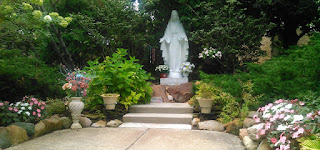
Rev. Edwin Balazy has been pastor of the small parish since 198; the parish school closed in 1995 due to low enrollment. However, the parish subsidizes tuition to help parishioners attend other parochial schools. Children from the parish also attend religious education programs at nearby St. Albert the Great.


St. John the Baptist has approximately 200 registered households, many of whom are elderly. Regardless, the small parish raised approximately $119,000 in 2013's Changing Lives Together Campaign.

The Lamb of God shown in a pediment above the sanctuary.

Engraved wood panels in the sanctuary show four seraphim, fleurs-de-lis, crowns, and wheat.

The left altar shows Madonna and Child along with St. Joseph; the tabernacle stands at the right altar.


Daily Mass is at 8:15am, Monday–Saturday, preceded by Confessions at 7:45am. Confessions are also heard 3:30pm–4:00pm on Saturdays followed by Vigil Mass is 4:30pm. Sunday Masses are at 9:00am and 11:00am.


More info: Archdiocese of Detroit + Changing Lives Together
More photos: AOD Film Services
Another blog post: Discovering Detroit Catholic Churches














































